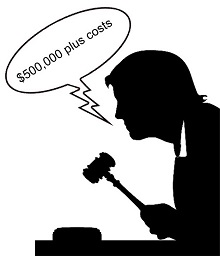submit to a yearly assessment of their musculo-skeletal health status and work
related stress.
CONTEXT
I've had a few jobs in my time, but never have I had to sign a workers
compensation insurance policy document, despite the fact that if
I'd been the victim of a workplace accident, I'd be the principal
beneficiary.
No-one has ever given me a risk assessment, despite the fact that over
the years treatments for personally-generated body system dysfunctions
have come to take up more and more of the workers compensation dollar.
No-one has ever pointed out what it is costing the organisation per
person for workers compensation premiums or how I could possibly help
lower that figure.
What I do known is that there are a lot of organisations paying in the
vicinity of $2,000 per staff member to insure them, when it's costing
similar organisations only $500. Same (sitting down) job, same pay,
massive difference in premiums.
EMPLOYERS
Employers have a responsibility to keep the workplace safe. They
have responsibility to provide their staff with information relating to
all manner of hazards, including those that involve things like lifting,
sitting down all day etc etc.
WHS managers have a responsibility to protect the organisation's bottom
line by measuring, managing and monitoring risks relating to potential
workers compensation claims - including those that relate to the
external environment of the workplace (accidents) and the 'internal environment' of
employees: ie their health, fitness and wellbeing.
EMPLOYEES
Employees have a responsibility to keep themselves fit and
healthy to do their job without breaking down. For example an employer
is unlikely to want to support claims for personally-generated
musculo-skeletal dysfunctions.
You can gain an appreciation of the variations in musculo-skeletal health by
scrolling through the
Musculo-skeletal Risk Evidence Spreadsheet. Here's the link to the
risk
assessment.
So, will an employer support a claim for injury caused by an accident? 'Definitely'.
Will an employer support a claim for a herniating a disc caused while cleaning a desk,
sitting in a chair or lifting a box of files out of the boot of a car?
'Doubtful' - particularly if the person making the claim has made no
effort to improve their musculo-skeletal health. You can read more about
such claims on page 36 of the
Workplace
Accident Insurance Blue Print.
PERSONAL RISK ASSESSMENT
One of the responsibilities of employees is to undertake two risk
assessments (musculo-skeletal health and stress risk) so their employer knows exactly what they're insuring.
With most insurances the premium is rated against
risk. In the workers compensation field this rating of premiums against
risk does not apply. In fact in most jurisdictions in Australia it's illegal.
This means organisations have to measure, manage and monitor the risk themselves and keep
claims for accidents and personally generated joint and muscle pain -
and stress - to an absolute minimum.
You can view our assessments on this link:
http://www.millerhealth.com.au/assessments/index.html
In particular
- Musculo-skeletal Health Risk
- Clinical Diagnostic Assessment
- Health Climate Survey
- Stress Risk
- Career Satisfaction.
|
We do these risk assessments in a group setting
during our musculo-skeletal health and stress management
seminars.
The musculo-skeletal and stress management
seminars take two hours with 20 - 25 participants in each
group.
In the course of a day we can run four of
these assessments.
The cost: infinitesimal compared with the
costs generated in the case outlined on page 36 of the
Blueprint.
If you'd like more information on how you can
lower your workers compensation costs, use the
contact details at the bottom of this page.
In the meantime stay tuned highly tuned and flick through
the Blueprint and see if you can't make some savings to your
workers compensation arrangements.
|

|